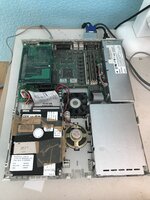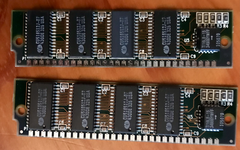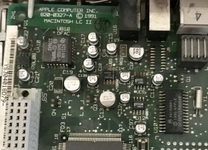Snial
Well-known member
I keep waxing lyrically about my 31 year old Performa 400 that just seems to keep on going. The Mac resides at my Dad's house, but when I tried to power it up earlier today I got nothing. I did plug in one of the Macintosh LC microphones that I got with the Mac, but I don't think it's likely to short (is it?) and I would have thought that that wouldn't blow the whole board.
So, I guess it's most likely to be the PSU (or. a fuse?). It's never been recapped. I took the lid off and powered it on, but the fan didn't go. Rats I didn't even check if it was a mains fuse that failed. Anyway, here's what the inside of the Performa 400 looked like:

It has an ethernet PDS card (10-base T). The PSU seems OK.

No caps appear to be bulging, doesn't seem to smell. I've just checked the internal PSU fuse and that seems to be OK. I guess the next test is to power it and check the voltage outputs? Do I need to apply a load? If so, where?
Thanks in advance, Julz.
So, I guess it's most likely to be the PSU (or. a fuse?). It's never been recapped. I took the lid off and powered it on, but the fan didn't go. Rats I didn't even check if it was a mains fuse that failed. Anyway, here's what the inside of the Performa 400 looked like:

It has an ethernet PDS card (10-base T). The PSU seems OK.

No caps appear to be bulging, doesn't seem to smell. I've just checked the internal PSU fuse and that seems to be OK. I guess the next test is to power it and check the voltage outputs? Do I need to apply a load? If so, where?
Thanks in advance, Julz.



